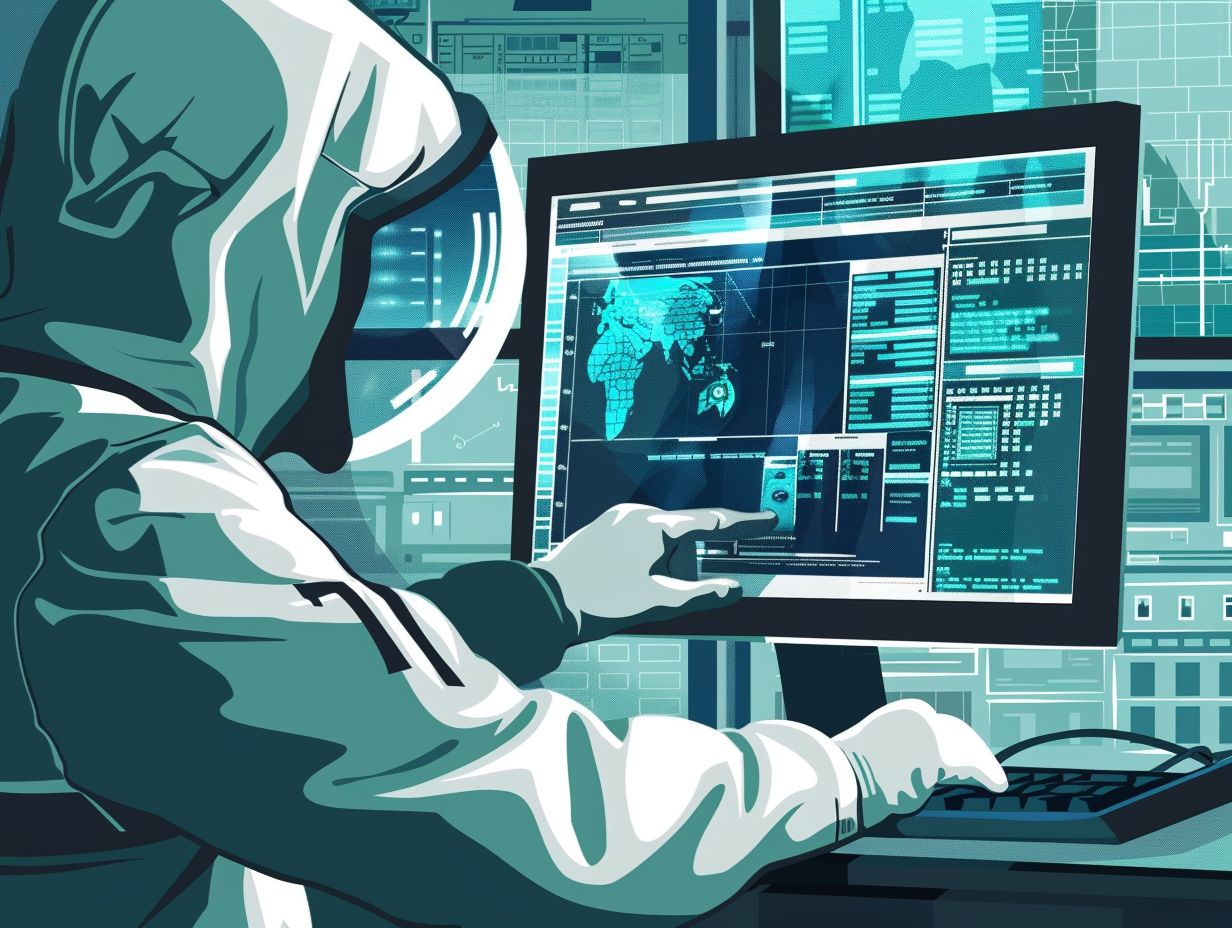In today’s digital age, the role of a Certified Incident Handler is more crucial than ever. This article explores the responsibilities and importance of a CIH, while also delving into the world of digital forensics and its various applications.
From defining key concepts in digital forensics to discussing the process of conducting an investigation, you will gain valuable insights into this field. Real-world examples and case studies will be examined, along with ethical and legal considerations in digital forensics. Join us on this journey as we uncover the fundamentals of digital forensics through EC-Council’s Certified Incident Handler program.
Key Takeaways:

The Role of a Certified Incident Handler
A Certified Incident Handler is a pivotal figure in the cybersecurity landscape, possessing advanced incident handling skills and knowledge. These professionals undergo training and certification by organizations like EC-Council to adeptly respond to cybersecurity incidents.
Your responsibilities as a Certified Incident Handler include swiftly identifying, analyzing, and responding to security incidents to minimize the impact on an organization’s systems and data. Leveraging your expertise, you are instrumental in investigating the root causes of incidents, executing corrective actions, and formulating strategies to prevent future breaches. The presence of Certified Incident Handlers on incident response teams guarantees a structured and efficient approach to managing cybersecurity incidents, thereby enhancing overall resilience and security posture.
Responsibilities and Importance
The responsibilities of a Certified Incident Handler encompass a wide range of tasks, including timely detection, response, and resolution of cybersecurity incidents. The importance of a Certified Incident Handler lies in their ability to minimize the impact of cyber threats and protect an organization’s digital assets.
Certified Incident Handlers play a crucial role in safeguarding sensitive information and maintaining the integrity of systems through their adept handling of incident detection, containment, eradication, and recovery processes. By leveraging their expertise and tools endorsed by organizations like EC-Council, these certified professionals are equipped to swiftly identify and mitigate security breaches, ensuring minimal disruption to business operations. Their proactive measures help enhance overall cybersecurity resilience, demonstrating the value of having certified professionals in place to combat evolving cyber threats.
Defining Digital Forensics and Its Uses
Digital Forensics is a specialized field that involves the investigation and analysis of digital evidence related to cybercrime. It plays a crucial role in identifying and attributing cybercriminal activities through forensic analysis.
This field utilizes various techniques to collect, preserve, and examine data from digital devices to uncover crucial information that can be used in legal proceedings. Digital Forensics Fundamentals, a subset of digital forensics, focuses on analyzing computer systems, networks, and storage devices to recover deleted files, detect unauthorized access, and reconstruct digital activities.
By meticulously examining digital footprints left behind by cybercriminals, Computer Forensics enables investigators to trace the origins of attacks, identify perpetrators, and present compelling evidence in court.
Key Concepts in Digital Forensics
In Digital Forensics, key concepts center around forensic investigation techniques utilized to analyze cybersecurity incidents. Forensic analysts and investigators play a critical role in the examination of digital evidence to unveil the nature and origins of security breaches.
Utilizing a range of forensic analysis methodologies like disk imaging, network traffic analysis, and memory forensics, they collect and preserve evidence in a forensically sound manner. The process of evidence collection may include the seizure of physical devices, capturing volatile data, and documenting the chain of custody. Analysis techniques encompass timeline analysis, keyword searching, and data carving to reconstruct events and recover deleted data. Through these systematic approaches, forensic investigators aim to ascertain the scope of a breach, identify perpetrators, and fortify the security posture of the organization.
Chain of Custody and Evidence Preservation
In forensic investigation of cybersecurity incidents, the Chain of Custody and Evidence Preservation play vital roles. Ensuring a secure chain of custody is crucial to maintaining the integrity and admissibility of digital evidence in forensic analysis.
It is imperative to properly document the seizure, storage, and transfer of digital evidence along the chain of custody to establish that the evidence collected has not been tampered with or compromised. By adhering to strict protocols for evidence preservation, forensic analysts can confidently present their findings in legal proceedings, enhancing the credibility of their investigative work. This meticulous approach also aids in establishing a clear timeline of events, identifying potential suspects, and ultimately facilitating a more effective response to cyber incidents.
Common Tools and Techniques

In digital forensics, you rely on a variety of tools and techniques to effectively analyze cybersecurity incidents. These tools include forensic software applications and specialized hardware devices that assist forensic investigators in collecting and analyzing evidence.
Forensic tools are crucial during the data acquisition phase, allowing investigators to collect digital evidence from various sources like computers, mobile devices, and networks. After acquiring the data, forensic tools support detailed analysis by enabling investigators to inspect files, metadata, and system artifacts for indications of malicious activity or unauthorized access. These tools aid in producing comprehensive reports that document findings, analysis procedures, and conclusions, which are vital for presenting evidence in legal proceedings.
The Digital Forensics Process
The Digital Forensics Process involves a systematic and step-by-step guide to conducting investigations into cybersecurity incidents. It encompasses data acquisition, forensic analysis, and reporting to uncover the root cause of security breaches.
During the data acquisition phase, you, as an investigator, collect digital evidence such as files, emails, logs, and metadata from various sources like computers, mobile devices, and cloud storage. This evidence must be carefully preserved to maintain its integrity and authenticity and is a must-have skillset in EC Council’s forensics and incident response.
Forensic analysis techniques include keyword searching, file carving, timeline analysis, and memory forensics to reconstruct events and identify potential threats. After analyzing the evidence, you document your findings in a detailed report that outlines the methodologies used, the results obtained, and any recommended actions for preventing similar incidents in the future.
Step-by-Step Guide to Conducting an Investigation
When conducting a digital forensics investigation, you need to adhere to a step-by-step guide that encompasses evidence identification, preservation, examination, analysis, and reporting. Each phase of the investigation process is critical in revealing pivotal insights into cybersecurity incidents.
In the initial stage of evidence identification, it is imperative to identify all possible sources of digital evidence, which may include computers, mobile devices, and cloud storage. Applying proper preservation techniques is essential to maintain the integrity of the evidence for subsequent digital forensics mastery.
In the examination phase, forensic specialists utilize specialized tools to extract and interpret data from the gathered evidence. Analysis entails meticulously examining the extracted data for patterns, anomalies, and potential indicators of malicious activity. Accurately reporting findings is crucial for legal proceedings or organizational decision-making.
Real-World Examples and Case Studies
Real-world examples and case studies can provide you with valuable insights into the application of digital forensics when analyzing cybersecurity incidents. By examining past cases and their outcomes, you, as a forensic investigator, can enhance your skills and response strategies.
For example, in a high-profile data breach case involving a large financial institution, digital forensics experts were able to identify the source of the breach by tracing the malicious code back to an insider threat. Through detailed forensic analysis of network logs and system files, they discovered unauthorized access points and implemented security measures to prevent future incidents. This illustrates how digital forensics not only reveals the root cause of cybersecurity incidents but also assists in fortifying the overall cybersecurity posture.
Examining Past Incidents and Their Outcomes
Examining past incidents and their outcomes is essential for understanding the effectiveness of digital forensics in addressing cybersecurity incidents. By analyzing the challenges, strategies, and results of forensic investigations, you can enhance your incident response capabilities.
One notable cyber forensics case study that showcases the significance of digital forensics in incident response is the Equifax data breach of 2017. During this incident, sensitive personal information of over 147 million individuals was compromised, leading to severe repercussions for the company.
You may recall that digital forensic experts were called in to conduct a thorough investigation to determine the scope of the breach, identify the vulnerabilities exploited by the attackers, and recover valuable evidence. Through advanced forensic analysis techniques, such as memory forensics and network traffic analysis, the team was able to trace the source of the breach and provide crucial insights for strengthening Equifax’s cybersecurity measures. Learn more about EC-Council’s Certified Incident Handler: Malware Analysis.
This case highlights the critical role that digital forensics plays in mitigating the impact of cyber incidents and preventing future breaches.
Ethical and Legal Considerations in Digital Forensics
Ethical and legal considerations play a critical role in digital forensics, ensuring that investigations adhere to industry standards and practices. Upholding privacy and confidentiality is paramount in maintaining the integrity of forensic processes and respecting individuals’ rights.
When engaging in digital forensic examinations, you must navigate a complex landscape of laws and regulations. This involves obtaining proper consent to access digital evidence, protecting sensitive information, and ensuring the chain of custody is preserved. Compliance with legal frameworks such as the Fourth Amendment in the U.S. or the GDPR in the European Union is crucial. By following these guidelines, digital forensics experts can conduct their investigations ethically and legally while safeguarding the rights and interests of all parties involved.
Adhering to Industry Standards and Practices

Adhering to industry standards and best practices is crucial in digital forensics to uphold the credibility and reliability of forensic investigations. As a cybersecurity professional, you must ensure forensic readiness and compliance with established guidelines to maintain the integrity of your investigative processes.
Being compliant with industry standards not only guarantees that investigations are conducted ethically and accurately but also aids organizations and individuals in establishing trust with stakeholders. By adhering to established guidelines, digital forensics experts can mitigate risks related to potential challenges such as legal issues and the admissibility of evidence in court.
Integrating forensic readiness into the overarching cybersecurity strategy facilitates a prompt and effective response to incidents, ensuring the protection of critical digital assets and the efficient preservation of evidence.
Ensuring Privacy and Confidentiality
Ensuring privacy and confidentiality is a fundamental principle of digital forensics, especially when handling sensitive data and information. Regarding managing investigations, forensic investigators must prioritize strict confidentiality measures in order to safeguard the integrity and privacy of the individuals involved.
This commitment to privacy and confidentiality also encompasses the ethical considerations that govern the actions of forensic experts. Adhering to ethical standards guarantees that investigations are carried out with honesty and consideration for the rights of individuals whose data is under scrutiny. It is crucial for forensic investigators to comply with data protection laws and regulations to prevent unauthorized access or disclosure of sensitive information. By consistently following these guidelines, forensic professionals demonstrate their accountability in protecting confidential data throughout the investigative process.
Frequently Asked Questions
What is EC-Council’s Certified Incident Handler certification?
EC-Council’s Certified Incident Handler (ECIH) is a comprehensive program designed to provide the fundamental skills and knowledge needed to effectively handle and respond to computer security incidents. It covers topics such as incident handling process, evidence collection and preservation, and digital forensics fundamentals.
What is the importance of digital forensics in incident handling?
Digital forensics is an essential aspect of incident handling as it involves the identification, collection, preservation, and analysis of digital evidence to determine the cause and scope of an incident. It helps in understanding the extent of the attack, identifying the attacker, and preventing future incidents.
What are the prerequisites for obtaining the ECIH certification?
To obtain the ECIH certification, candidates must have at least two years of experience in information security or related fields, have completed the ECIH training program, and passed the ECIH exam.
Is the ECIH certification recognized internationally?
Yes, the ECIH certification is recognized globally and is accredited by the International Council of Electronic Commerce Consultants (EC-Council).
What are the benefits of obtaining the ECIH certification?
The ECIH certification demonstrates a candidate’s expertise in incident handling and digital forensics, making them a valuable asset to any organization. It also opens up opportunities for career advancement and higher salaries.
What topics are covered in the ECIH training program?
The ECIH training program covers topics such as incident handling process, threat and vulnerability management, evidence collection and preservation, and digital forensics fundamentals. It also includes real-world scenarios and hands-on labs to provide practical experience.
<img alt=" Digital forensics is an essential aspect of incident handling as it involves the identification, collection, preservation, and analysis of digital evidence to determine the cause and scope of an incident. It helps in understanding the extent of the attack, identifying the attacker, and preventing future incidents. What are the prerequisites for obtaining the ECIH certification? To obtain the ECIH certification, candidates must have at least two years of experience in information security or related fields, have completed the ECIH training program, and passed the ECIH exam. Is the ECIH certification recognized internationally? Yes, the ECIH certification is recognized globally and is accredited by the International Council of Electronic Commerce Consultants (EC-Council). What are the benefits of obtaining the ECIH certification? The ECIH certification demonstrates a candidate's expertise in incident handling and digital forensics, making them a valuable asset to any organization. It also opens up opportunities for career advancement and higher salaries. What topics are covered in the ECIH training program? The ECIH training program covers topics such as incident handling process, threat and vulnerability management, evidence collection and preservation, and digital forensics fundamentals. It also includes real-world scenarios and hands-on labs to provide practical experience.” width=”616px” src=”https://securetechinstitute.com/wp-content/uploads/2024/05/ec-councils-certified-incident-handler-digital-forensics-fundamentals-R4.jpeg” />
